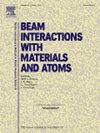Evolution of dislocation loops in chromium under single hydrogen and helium ion irradiation
IF 1.4
3区 物理与天体物理
Q3 INSTRUMENTS & INSTRUMENTATION
Nuclear Instruments & Methods in Physics Research Section B-beam Interactions With Materials and Atoms
Pub Date : 2025-02-01
DOI:10.1016/j.nimb.2024.165602
引用次数: 0
Abstract
Dislocation loops, which are typical irradiation defects, can be influenced by hydrogen and helium produced by transmutation reactions. The evolution of dislocation loops in chromium (Cr) coatings under room temperature irradiation with single H+ and He+ is observed using transmission electron microscopy (TEM). At equivalent damage levels, the density of dislocation loops is higher under irradiation with He+ compared to that with H+. This indicates that helium promotes the nucleation of dislocation loops more effectively than hydrogen does, whereas hydrogen promotes the growth of dislocation loops more, resulting in larger loop sizes. Irradiation with both hydrogen and helium ions resulted in the formation of more a0 〈100〉 dislocation loops in Cr, comprising roughly half of the total observed loops.
单氢和氦离子辐照下铬中位错环的演化
位错环是一种典型的辐照缺陷,可受嬗变反应产生的氢和氦的影响。用透射电镜(TEM)观察了室温单H+和He+辐照下铬(Cr)涂层中位错环的演变过程。在同等损伤水平下,He+辐照下的位错环密度高于H+辐照。这说明氦比氢更能有效地促进位错环的成核,而氢更能促进位错环的生长,导致位错环的尺寸更大。氢离子和氦离子辐照导致Cr中形成更多的a0 < 100 >位错环,约占观察到的位错环总数的一半。
本文章由计算机程序翻译,如有差异,请以英文原文为准。
求助全文
约1分钟内获得全文
求助全文
来源期刊
CiteScore
2.80
自引率
7.70%
发文量
231
审稿时长
1.9 months
期刊介绍:
Section B of Nuclear Instruments and Methods in Physics Research covers all aspects of the interaction of energetic beams with atoms, molecules and aggregate forms of matter. This includes ion beam analysis and ion beam modification of materials as well as basic data of importance for these studies. Topics of general interest include: atomic collisions in solids, particle channelling, all aspects of collision cascades, the modification of materials by energetic beams, ion implantation, irradiation - induced changes in materials, the physics and chemistry of beam interactions and the analysis of materials by all forms of energetic radiation. Modification by ion, laser and electron beams for the study of electronic materials, metals, ceramics, insulators, polymers and other important and new materials systems are included. Related studies, such as the application of ion beam analysis to biological, archaeological and geological samples as well as applications to solve problems in planetary science are also welcome. Energetic beams of interest include atomic and molecular ions, neutrons, positrons and muons, plasmas directed at surfaces, electron and photon beams, including laser treated surfaces and studies of solids by photon radiation from rotating anodes, synchrotrons, etc. In addition, the interaction between various forms of radiation and radiation-induced deposition processes are relevant.

 求助内容:
求助内容: 应助结果提醒方式:
应助结果提醒方式:


